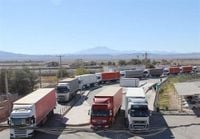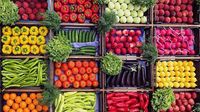Iran's agricultural exports have surged significantly over the past year, marking a notable shift in the country’s economic strategy as it seeks to diversify away from reliance on crude oil revenues. According to the Iranian customs office (IRICA), agricultural exports rose by nearly a third in the calendar year ending March 20, 2025, reaching a total value of $5.2 billion, which represents a 29% increase from the previous year.
The IRICA report, highlighted by the ISNA news agency, also revealed that the volume of Iranian export shipments increased by 11%, totaling 7.6 million metric tons during the same period. This growth is a testament to the Iranian government's ongoing efforts to bolster its agricultural sector amidst economic challenges.
Pistachios emerged as the star of Iran's agricultural exports, generating approximately $1.5 billion in revenue. This figure underscores the importance of pistachios to the Iranian economy, as they remain one of the country's most sought-after products in international markets. Fishery exports also showed a robust increase, climbing 17% to reach $372 million, with shrimp and tuna fish being the primary items exported.
China, Iraq, and the United Arab Emirates (UAE) were identified as the main buyers of Iranian fishery products, reflecting the strong demand for these goods in neighboring and regional markets. Additionally, the IRICA data indicated that Iran exported $233 million worth of tomatoes and $205 million in dates over the past calendar year. Saffron, another key agricultural product, contributed $185 million to the country's export revenues, with the UAE, Spain, and China being the main destinations for this highly valued spice.
In a related development, the province of Khorasan Razavi in northeastern Iran reported a remarkable 34% increase in its non-oil exports for the year ending March 20, 2025. According to Javad Jafari from the province's customs department, Khorasan Razavi exported 3.463 million tons of non-oil goods valued at $2.251 billion, which also reflects an 18% rise in weight year-on-year.
The main items exported from Khorasan Razavi included agricultural products, pistachios, saffron, polyethylene compounds, and various metal products. The province's major trading partners during this period were Afghanistan, Tajikistan, Turkmenistan, Uzbekistan, and Iraq, showcasing the region's strategic position in facilitating trade with its neighbors.
On the import side, Khorasan Razavi saw 321,000 tons of non-oil commodities valued at $786 million enter the province, which marks a 6% increase in value and a 7% increase in weight compared to the previous year. Key imported goods included cotton, yarn, smartphones, gold bars, and rice, with the UAE, China, Tajikistan, Uzbekistan, and Turkey serving as the primary sources of these imports.
Overall, Iran's non-oil export landscape has shown significant improvements. In the past Iranian calendar year, the country exported over 152 million tons of non-oil goods worth $57.8 billion, indicating a 10% increase in volume and a 15.62% rise in value compared to the previous year. Despite these gains, Iran faced a non-oil trade deficit of $14.6 billion, largely attributed to the import of over $8 billion worth of raw gold bars, which constituted 11.12% of total import value.
The Iranian government has emphasized the need to reduce reliance on oil revenues, and these export figures suggest positive momentum in that direction. The top non-oil exports included natural gas, liquefied propane and butane, methanol, and gas condensates. Notably, natural gas topped the list of exports with an average customs value of $314 per ton.
China remains Iran's largest trading partner, accounting for $14.8 billion of total exports, followed by Iraq at $11.9 billion and the UAE at $7.2 billion. Collectively, these countries represented 82.3% of Iran's total non-oil export value. The diversification of exports is crucial, especially as Iran navigates international sanctions and economic pressures.
As Iran continues to develop its agricultural and non-oil sectors, the government is hopeful that these trends will lead to a more resilient economy. The increased agricultural exports not only reflect a strategic pivot but also highlight the potential for growth in sectors that have long been overshadowed by oil revenues.
In conclusion, the significant rise in agricultural and non-oil exports from Iran signals an important shift in the country’s economic landscape, as it strives to bolster its economy through diversification and increased trade with neighboring countries.


